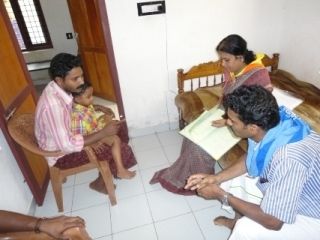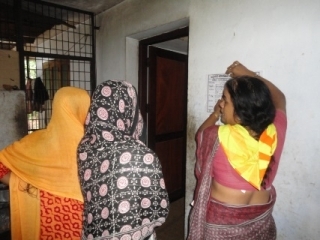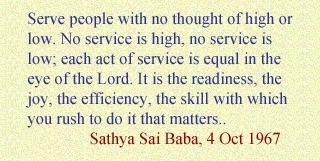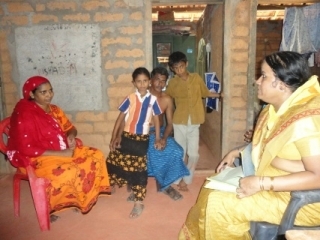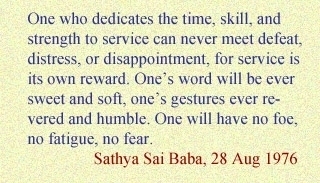

Introduction
Any patient may regain full health after a surgical operation, but utmost care must be taken during the post-operative period. Any negligence or carelessness may lead to a dangerous situation, which may turn out to be more complicated than the disease or medical problem of which the patient has been relieved. In many hospitals, patients go for post-operation check-ups and get proper advice and follow necessary precautions until they are completely cured. Sri Sathya Sai Baba of India has established a world-class model of two gigantic hospitals that treat patients free of cost, irrespective of caste, creed, colour, religion, nationality, etc. Since the treatment is free, most of the patients come from very poor economic status and lack even minimum knowledge of health and hygiene.
Project Details
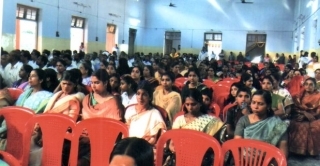 Sri Sathya Sai Seva Organisation (SSSO) in India has established a working wing to look after patients who have been operated on in the Puttaparthi and Bangalore hospitals, to guide and keep in touch with these beneficiaries. Kerala State Organisation utilizes a very systematic approach to look after these people, as they are scattered around the state. A perfect “human chain”mechanism has been established, called “Sai Rehabilitation Programme” (SRP), also known as Hrudaya Sangamam – A Touch With Heart. The SRP started with 400 patients in 2009 and grew to serve about 3,000 by early 2013.
Sri Sathya Sai Seva Organisation (SSSO) in India has established a working wing to look after patients who have been operated on in the Puttaparthi and Bangalore hospitals, to guide and keep in touch with these beneficiaries. Kerala State Organisation utilizes a very systematic approach to look after these people, as they are scattered around the state. A perfect “human chain”mechanism has been established, called “Sai Rehabilitation Programme” (SRP), also known as Hrudaya Sangamam – A Touch With Heart. The SRP started with 400 patients in 2009 and grew to serve about 3,000 by early 2013.
Working Method
The Kerala Sai Organisation obtains the list of patients operated on, along with their address, village, and district details, and sevadal (corps of service volunteers) workers visit the patients and provide guidance. Aspects of the programme include:
1. Providing guidance on how to be careful during the post-operative period.
2. Conducting regular camps in each District to give blood pressure and other tests.
3. Each district’s SRP is headed by a cardiologist or general medicine doctor.
4. The programme is supported by the Sri Sathya Sai Institute of Primary Health Care, Shoranur.
5. New volunteers in the work force will be developed by conducting training camps once in a year to effectively monitor and sustain the rehab programme.
6. The patient is given a paper with the name and phone numbers of the SRP District coordinator where they reside.
7. A pro-forma for follow up is sent to the central state SRP office at Shoranur.
8. The central state SRP office also gets a list of patients discharged from the Bangalore hospital.
9. Patients contact the SRP in-charge directly, for any post-operation help.
Patients are categorized into three groups:
1. Those who need total help, such as medicines, financial help, and provision of food and other necessities in life. These are called Adopted Patients, meaning they are totally taken care of by the RSP. Today there are 120 such people, and the Kerala SSSO has extended help beyond expectation, such as building houses, conducting marriages of patients’ children, and providing vocational rehabilitation.
2. Those who need only medicines and who can otherwise take care of themselves.
3. Those who do not need any extra help from this programme. They are, however, given counseling and home visits and are monitored regarding their lifestyle, etc.
Most successful results
Patients are seen regularly in their homes, and sessions are conducted that include their family members and neighbours. This is where active counseling is given, and the volunteer case workers have been trained in basic listening skills.
All patients who have completed the initial series of three check-ups are invited to a get-together once every six months. We call the gathering Hridayasangamam (Confluence of Hearts). Here patients meet informally and are usually addressed by a cardiologist or counsellor who gives talks on lifestyle.
Patients get an opportunity to speak about modification of diet etc. Here it is ascertained whether the patients are following the instructions given them by their hospitals and whether the necessary follow-up investigations are being done, especially in the case of those who have had valve surgeries. If the patient is in default in this regard due to financial reasons, the Sri Sathya Sai Samithi (center) nearest to their place of residence takes care of it.
Hridaya Sangamam meet
Recently a Hridayasangamam of Calicut was attended by 1,000 people who had received treatment or operations at the Sri Sathya Sai Super Speciality Hospitals, accompanied by their families. This event was attended by the State Health minister and a Member of Parliament.
Visit to the Divine Abode
All operated-upon patients were invited to participate in a Hridayasangamam at Puttaparthi, the birthplace of Sri Sathya Sai Baba, in 2010. The patients got the opportunity to speak in Sai Kulwant Hall, giving highly emotional outpourings of their love and gratitude to Sri Sathya Sai Baba.
The transformation
The Sai workers in Kerala were amazed at the level of devotion and love these patients and their families have for Sri Sathya Sai Baba, irrespective of their religious beliefs and social background. Many of the patients have become workers in the SRP and have begun working for other patients and performing services at Puttaparthi
And so the saga of Love in Action goes on . . .
Additional Info
Project Coordinator: Sri Sathya Sai Seva Organisation – Kerala
Contact Person: Prof E Mukundan, State President, Sri Sathya Sai Seva Organisation-Kerala State, mail ID: saisandesh@sify.com
Keywords
Health Check Up, Follow-up Medical Treatment, Poor People, Visits to patients homes, Extended medical help, Kerala State Sai Organisation, SSSO-Kerala, Hridaya SangamamProject Details
Project start: 09/01/09
Project completion:
Stage of development:
Zone name: India
Lat/Longitude: 10° 45' N 76° 16' E
Affiliation: Sri Sathya Sai Seva Organisation, Kerala
Service category: Medical clinic/camp
Author: Vishnu Donger
Project leader: Prof E Mukundan
